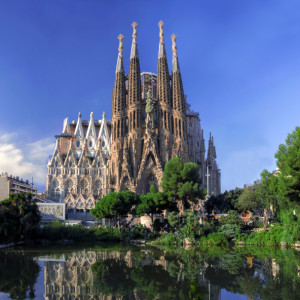
There are many beautiful churches, but some are true architectural wonders. A number of the most celebrated were built without the help of modern technology but are masterpieces of engineering nonetheless. It is difficult to image how many of them were constructed without some form of divine intervention.
Sagrada Familia
Sagrada Familia, also known as Basilica I Temple Expiatori de la Sagrada Familia, is located in Barcelona and was designed by renowned Spanish architect Antoni Gaudi. Work began on the church in 1883 and is still not finished. Gaudi was devoted to the project and worked on it until he died in 1926. At the time of his passing, the church was around 15–25 percent complete. Today, it is over 50 percent done and it is estimated it will be finished in 2026, which is the 100th anniversary of the architect’s death. Sagrada Familia is a unique combination of Gothic and Art Nouveau architecture, and there is nothing like it anywhere in the world. Its unfinished state is attributed to several factors; the project has relied on private funds to finance construction, and the church’s building has been a divisive issue for the residents of Barcelona. The Spanish Civil War also interrupted construction in the 1930s.
Church of Hallgrimur
Reykjavik’s Church of Hallgrimur took 38 years to complete and was consecrated in 1986. It is a masterpiece of modern design and is massive in scale; it is the biggest church in Iceland. It was named for Hallgrimur Petursson, the 17th century Icelandic clergyman and poet. According to the building’s architect, Guojon Samuelsson, the building is meant to resemble the lava flows that can be seen throughout Iceland. The church’s organ weighs 25 tons.
Notre-Dame de Paris
Also known simply as Notre-Dame, Notre-Dame de Paris is one of the most well-known cathedrals in the world and sits on the banks of the Seine River. The church was designed in the French Gothic style and has many stained glass windows. From an architectural standpoint, Notre-Dame is particularly noteworthy because it was one of the first structures to have “flying buttresses,” which are exterior supports, incorporated in the design. Construction on the church began in 1163 and was completed in 1345. Napoleon I and his wife, Josephine, were coronated there in 1804.
St. Basil’s Cathedral
The colorful onion-shaped domes of St. Basil’s Cathedral are synonymous with Moscow and Red Square. Ivan the Terrible ordered the building of the church and it was completed in 1561, after six years of construction. It has been a museum since 1928, after it was seized by the government from the Russian Orthodox community due to opposition to organized religion. The church is named for Saint Vasily, also known as Saint Basil.
Westminster Abbey
Most recently famed for being the location of Prince William’s wedding to Kate Middleton, Westminster Abbey is one of the world’s most historic and iconic churches. It is a top London tourist attraction and one of the most important religious buildings in all of Europe. The original structure was built on the site in the 10th century, and construction on the current building started in 1245, during the reign of Henry III. Westminster Abbey is particularly noteworthy because it is the place where numerous British monarchs and other members of the royal family are coronated, married and buried. Queen Elizabeth and Prince Philip exchanged vows there in 1947, and Princess Diana’s funeral was held at the church in 1997, although she is buried at her family’s estate in Northamptonshire. There are a number of other important historic figures buried at Westminster Abbey, including:
- Sir Isaac Newton,
- Charles Darwin
- Geoffrey Chaucer
Churches are important buildings in the history of the mankind. These six examples are some of the most spectacular, and justly deserve admiration.

